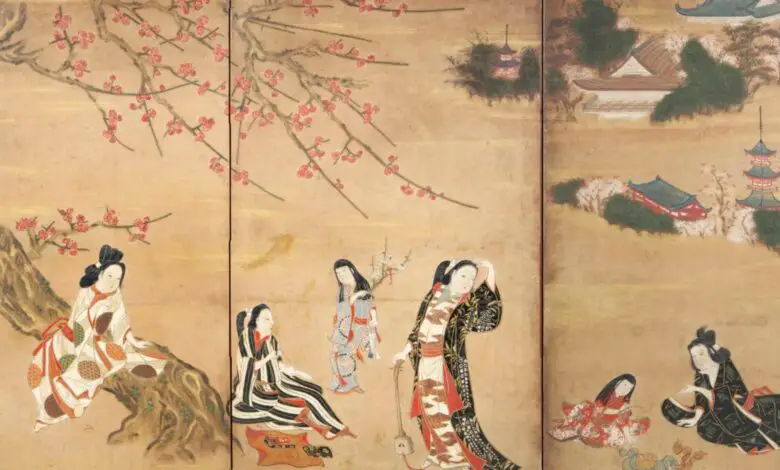Unveiling the Rich Tapestry: A Journey Through the History of Japanese Art
Unveiling the Splendor: A Comprehensive Exploration of Japanese Art Through the Ages

History of Japanese A In the realm of artistic expression, few cultures possess the depth, diversity, and intricacy as **Japanese art**. From ancient traditions rooted in spirituality to contemporary innovations reflecting modern society, the history of Japanese art is a captivating narrative of creativity, skill, and cultural identity.

Ancient Origins: The Birth of Japanese Art
The roots of Japanese art trace back to the Jomon period (10,000 BCE – 300 BCE), characterized by the emergence of pottery adorned with distinctive cord-mark patterns. This period witnessed the earliest manifestations of artistic expression, serving both utilitarian and symbolic purposes within early Japanese communities.
Subsequent periods, such as the Yayoi (300 BCE – 300 CE) and Kofun (300 CE – 538 CE) periods, witnessed the influence of continental Asian cultures, particularly from China and Korea. It marked a transformative era, as metalworking techniques and **Buddhist iconography** were introduced, laying the foundation for future artistic developments.
The Flourishing of Japanese Art: Heian to Edo Periods
Heian Period (794 CE – 1185 CE)
The Heian period is renowned for its profound cultural achievements, particularly in literature and **architecture**. It witnessed the flourishing of **courtly arts**, including elegant calligraphy, classical poetry (waka), and the development of the uniquely Japanese narrative form, **the Tale of Genji**. Buddhist art also thrived during this era, with the construction of magnificent temples and the proliferation of Buddhist sculpture.
Kamakura and Muromachi Periods (1185 CE – 1573 CE)
The Kamakura and Muromachi periods marked a shift towards **samurai culture** and Zen Buddhism, profoundly influencing artistic expressions. **Ink painting** (sumi-e) and **Zen gardens** emerged as prominent forms of artistic representation, embodying principles of simplicity, harmony, and transience. The rise of **tea ceremony** aesthetics further underscored the importance of refinement and mindfulness in Japanese art.
Edo Period (1603 CE – 1868 CE)
The Edo period witnessed a period of peace and stability under the Tokugawa shogunate, leading to unprecedented cultural flourishing. Woodblock printing (ukiyo-e) attained widespread popularity, portraying scenes of urban life, kabuki theater, and landscapes with unparalleled intricacy and vibrancy. **Kano school** of painting and Rinpa school exemplified the diversity of artistic styles during this period, reflecting a fusion of traditional Japanese aesthetics with new influences.
Modern Era: Meiji Restoration to Contemporary Innovations
Meiji Restoration (1868 CE – 1912 CE)
The Meiji Restoration marked a period of rapid modernization and Westernization, profoundly impacting Japanese art. Traditional art forms adapted to new techniques and materials, while artists explored themes of national identity and cultural revival. The establishment of art academies and exhibitions facilitated cross-cultural exchange, contributing to the diversification of artistic styles.
Taisho and Showa Eras (1912 CE – 1989 CE)
The Taisho and Showa eras witnessed dynamic shifts in Japanese art, reflecting the tumultuous socio-political landscape of the 20th century. Avant-garde movements such as **Gutai** and Mono-ha challenged conventional artistic norms, embracing experimentation and conceptualism. Japanese artists gained international recognition, with figures like **Yayoi Kusama, **Takashi Murakami**, and **Yoko Ono** leaving an indelible mark on the global art scene.
Contemporary Landscape: Diversity and Innovation
In the contemporary era, Japanese art continues to evolve, embracing new technologies, mediums, and perspectives. From digital art and manga to contemporary ceramics and performance art, **Japanese artists** exhibit unparalleled creativity and innovation. Cultural heritage remains a source of inspiration, as artists navigate complex intersections of tradition and modernity in their works.
Conclusion
The history of Japanese art is a testament to the enduring spirit of creativity and cultural resilience. From ancient origins rooted in tradition to contemporary expressions pushing boundaries, Japanese art captivates and inspires audiences worldwide. As we traverse the rich tapestry of Japanese artistic heritage, we are reminded of its profound impact on global artistic discourse and the timeless beauty it embodies.




